WORLD CLASS COACHING
Tactical Series Mauricio Pochettino
By James Lambert
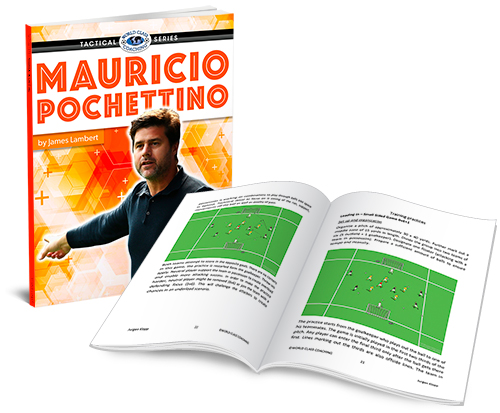
TABLE OF CONTENTS
Part One
INTRODUCTION
FORMATIONS
BALL POSSESSION
BALL POSSESSION TO BALL POSSESSION OPPOSITION
Part Two
BALL POSSESSION OPPOSITION
BALL POSSESSION OPPOSITION TO BALL POSSESSION
Part Three
FINISHING ACTIONS
TRAINING SESSION
INTRODUCTION
Mauricio Pochettino is an excellent tactical coach who has adapted to English football showing great innovation and creativity. He is strongly influenced by Marcelo Bielsa, evident in the strategies and mentality of the teams Pochettino develops.
The relationship between Pochettino and Bielsa started in 1985 when Bielsa was working in Youth development taking Pochettino into his set up at 13 years old. Bielsa is a mentor and role model for Pochettino but like all special coaches Pochettino has also implemented stamp on his teams. With an apprenticeship at Espanol to whom he finished is playing career with, success at Southampton leads to Tottenham coming in for the talented coach.
In 2011 I was given a task on my A license to analyse Chile Under 20s, the Chilean national teams were set up and managed by Marcelo Bielsa.
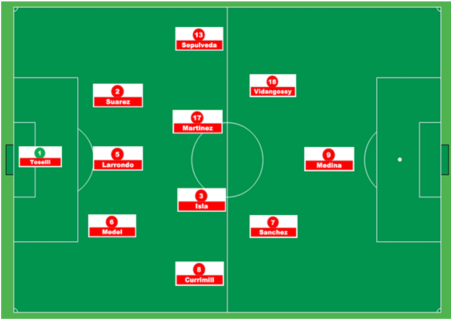
While coaches now are using different formations, they all allow for positional play; all have good passing support for all passes, due to the player positioning set up to support the ball carrier.
CHAPTER 1 - FORMATIONS
The 1-3-4-2-1 playing system fits the Tottenham team Pochettino is building with positional profiles matching to perfection.
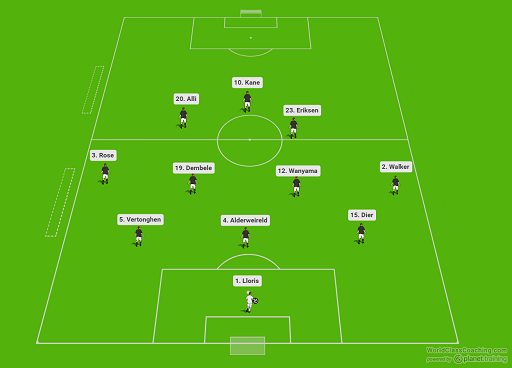
Lloris is a sweeper keeper who as great distribution, with good feet and an excellent shot stopper.
Rose and Walker are flexible to play in a back 4 and a back three system, but in a back three, they have even more license to push on and take the width.
Vertonghen, Alderweireld and Dier are all very mobile defenders with very good distribution long and short.
Holding Midfielders have the characteristics to screen, win balls but also have the technical skills to support the attack. Dembele is a complete footballer who is excellent in possession and often starts positive moves with his ability to run with the ball and change the tempo of the game.
Wanyama screens and breaks up play, he excels when the other team counters to slow or stop the counter attack. Wanyama is one of the best defensive midfielders in the game today.
The two deep lying creative players Alli and Eriksen have more freedom in this system, and it is this freedom that can add elements of surprise and creativity to the Tottenham attack. When Son is brought on he also give the team something different, he is excellent in tight areas. Positioning himself in the last line with perfectly timed runs or simple body shape to break the last line.
With Kane playing striker they have mobility, strength, a great team player and of course a goal scorer.
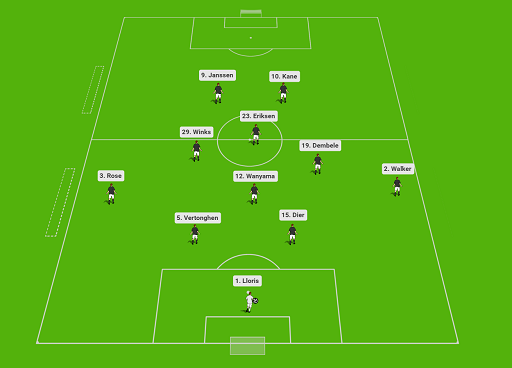
Tottenham also use a two striker system to fir in Janssen and Kane, this gives Dembele freedom to work with Alli, Eriksen, Winks or Son. The roles of Rose and Walker are the same, often pushing high to take the width.
When they have fall behind in games they have switched to the 4-2-3-1 to try and overload the central areas.
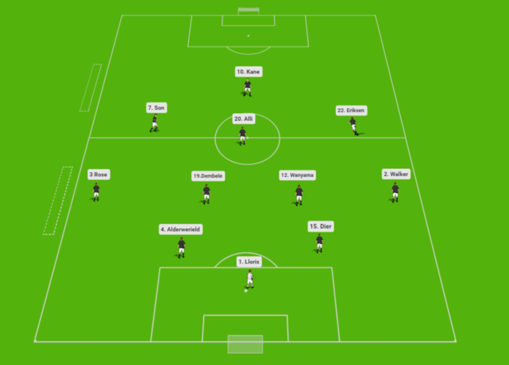
On the right side Eriksen plays inside inviting Walker to take the width, Son mostly plays out on the left but at times he may move to the right wing allowing Rose to push forward. The system is not rigid, it is very flexible with many central rotations to try and break down the opponent.
CHAPTER 2 – BALL POSSESSION
1-3-4-2-1 Build up patterns from the back third
In the early build up of a back three, both fullbacks push on to create a five man attack with the two attacking midfielders Alli and Eriksen ready to support. Tottenham mix their game up and do at times play longer balls.
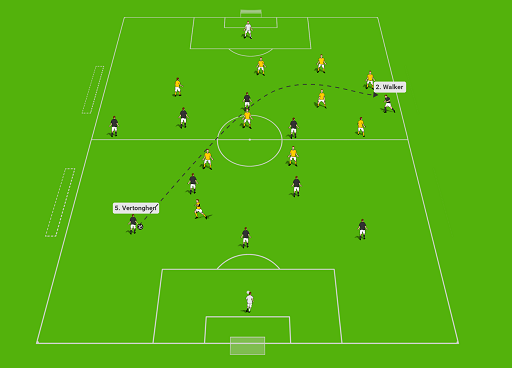
The switching ball is used on a regular basis to Walker who over loads the last line, often this pass is for him to knock down or drop off to supporting players.
Tottenham’s, Vertonghen, and Alderweireid have tremendous passing ranges and used a similar switch when playing for Ajax together. The Ajax switch was often after the defensive block had been moved over and the winger just had time to bring the ball down. In the case of Tottenham, Walker is used to challenge in the air with supporting players waiting for the knockdown.
This tactic reminds me of watching lower league football with wide players looking for flick-ons. The long ball below from Alderweireld is perfectly and purposely delivered to the head of Walker who drops it back to Eriksen.
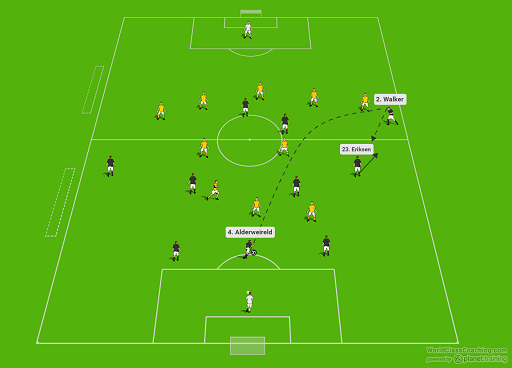
The intensity and level of support Tottenham players provide is difficult to match especially if they win the ball and knock it back.
In this game, the opponent often pressed with three strikers, so it was difficult for Tottenham to build out on every occasion. Lloris used the option of a long goal kick to Walker who attacks the ball well to drop it backward.
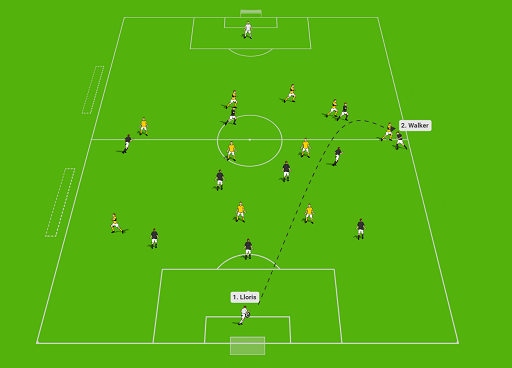
Kicking long into the wide areas stops the ball from coming straight back & makes it difficult for the opponent to win and start an attack.
Tottenham always looks to play out from the back and circulate the ball to find opportunities, so they may create forward passes.
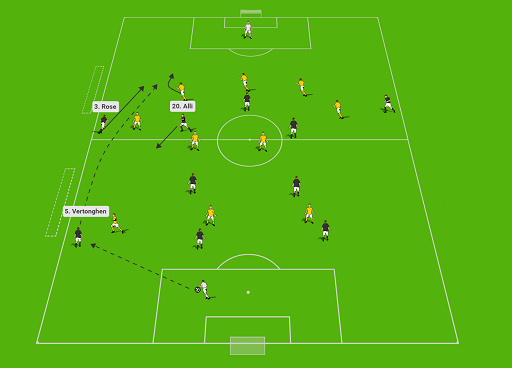
Breaking the last line through the longer ball, Alli drops to provide an option for a pass on the ground between the lines. This option was used on many occasions, Rose and Walker push very high and are always ready to make forward runs. Rose breaks the last line with his pace, and even though the pass is not ideal it turns the opponent around, and it becomes a 1v1 situation for the last line defender who clears for a throw in. Now in the front third Tottenham can set themselves up for a more structured attack.
Kane always an outlet when the team is under pressure, as he is always staying high and positioning himself in line with any possible forward balls.
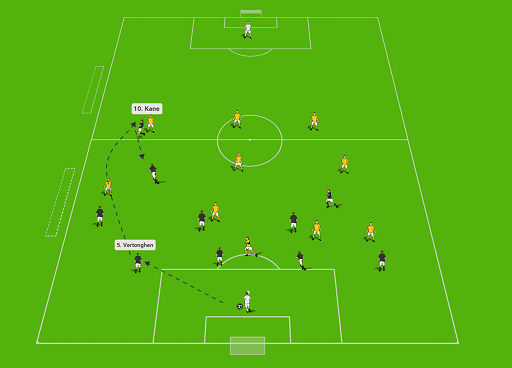
Tottenham players support this ball quickly with both Alli, Eriksen and the fullbacks Rose and Walker ready to break quickly.
1-3-4-2-1 Build up patterns from the middle third
Kane is always an option in the early build making runs for a variety of different passes. Kane is strong and difficult to mark, his movement towards the ball is quick, so the defenders are not able to steal the ball. See below a chip pass for Kane who drops to receive
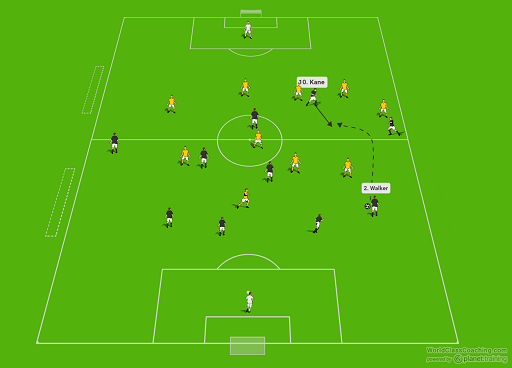
This type of ball is very difficult for the opponents to win, Kane is excellent at dropping, timing his movement and screening the ball.
Again below Kane drops but this time for a pass along the ground, with a quick touch, he circulates the ball to the other side to assist Tottenham in an attempt to search for space.
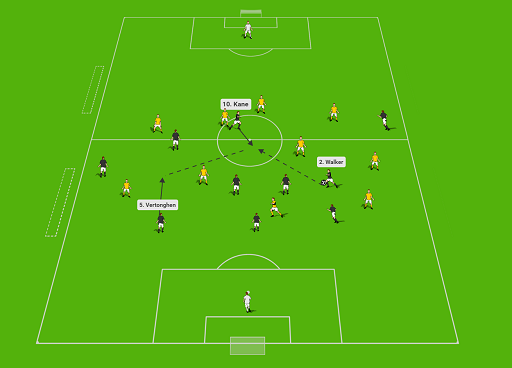
Both of Tottenham’s left, and right central defenders are very comfortable stepping forwards and involving themselves in the attack.
Penetrating passes along the ground between the lines are used too via the attack; the opponent is never quite sure if the ball is going over them or in front of them. The passing range and passing quality of the Tottenham defenders is of a very high level.
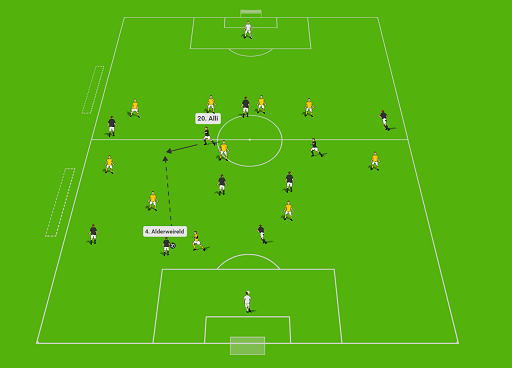
Passes between are very effective as the team may break through a defensive line of two or three players. The risk is high because the opponent can see the ball and uses this moment to try and intercept. If a player runs straight towards the ball, this pass carries a high risk. In the image above Alli makes a lateral run towards the ball, to try and pass around the corner to on running Rose. Lateral movement to a penetrating pass is good because the direct opponent is at a disadvantage as he is on the wrong side of the ball.
The shorter options of build up are through the creative midfielder Dembele, Dembele is tremendously skilful. Dembele enters into 1v1s against his direct opponents, Dembele is excellent at running with the ball and protecting it at the same time. He uses tactical dribbling to draw opponents before he releases to a free player. Dembele uses deception before he receives, on his first touch and can move the ball both ways if he doesn’t beat the direct opponent, he draws many fouls.
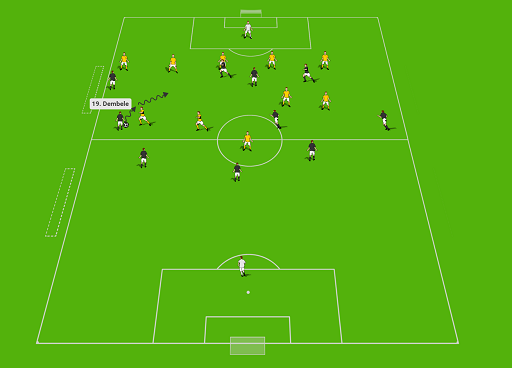
Dembele changes the dynamics of the attack, by beating his direct opponents and drawing the next one he eventually frees a teammate. The Tottenham team lift and a front third attack is started.
1-4-3-1-2 Build up patterns
Tottenham show great flexibility to playing formations, all built around key players with all their top players fitting well within each formation.

Fullbacks Rose and Walkers roles are very similar across all playing formations. Wanyama sits and screens, Dembele involves himself in all build ups with the ability to move up and down the park. Eriksen roams in the pocket looking for an opportunity to find space and create a positive action. Interestingly Pochettino will include a younger player if he feels he fits the profile of the playing system, in this case young English born midfielder Harry Winks.
When attacking in the 1-4-3-1-2 Tottenham are patient so they can circulate and build, giving time for the fullbacks Rose and Walker to get higher up the field. With midfielders playing short passes centrally it compresses the opponent and opens up the wide areas.
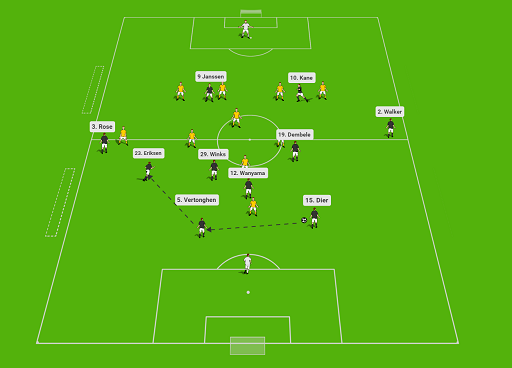
Once Rose and Walker move up field, the opponent’s wide midfielders are pulled back. With Tottenham using two strikers in the last line, the opponent’s back 4 are occupied due to the Tottenham strikers positioning between the central defenders and fullbacks.
Pochettino is giving the opponent a tactical problem, Eriksen dropping deep now finds space due to the Tottenham midfield 3 staying compact. With all of this in mind, we will now look at methods Tottenham use to break down the opponent.
Tottenham utilise the long switch options they have shown a strong tendency for, to break the last line.
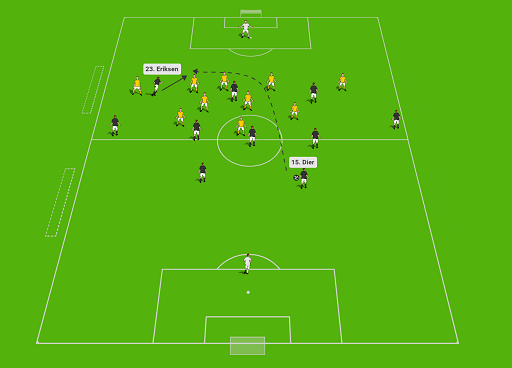
Eriksen moves into the last line creating a good angle for the long diagonal. The aim with this longer pass is to break the last line and create a goal scoring opportunity.
Tottenham with this goal again switch the ball through the compact midfield with Rose taking the width. Rose receives and takes on the defender, squaring the ball for Janssen.
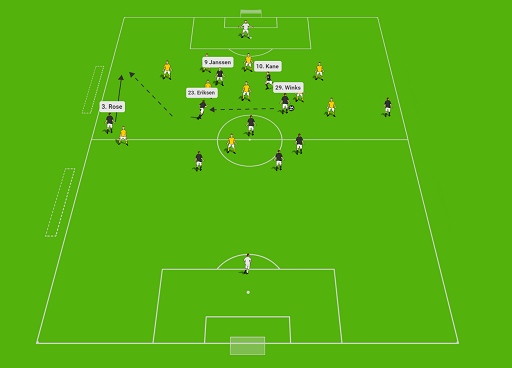
Janssen gets his shot away which is parried by the goalkeeper into the path of Winks.
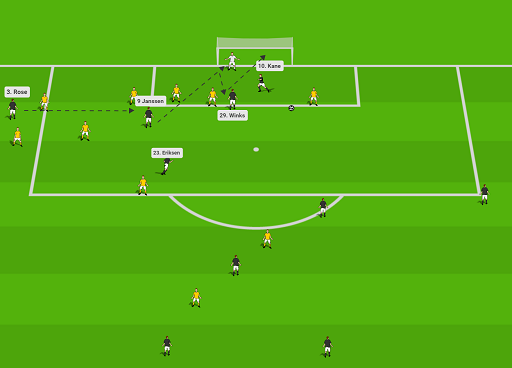
Winks reacts to the rebound to finish.
Tottenham even in tight spaces are looking for opportunities to break the last line, Alli works the ball with a 1-2 to shift the defender to try and find a forward pass.
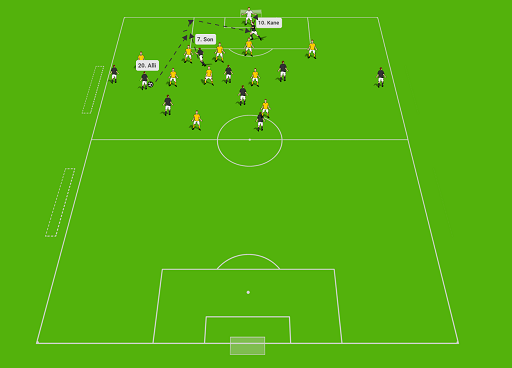
Son positions himself between defenders on the half turn looking to break the line. Son positioning does not allow him to see the goal but it does create the opportunity for a cut back for Kane.
Tottenham really do push themselves to try and get the positive result. A throw in on the left side in a very congested area still allows them to create an opportunity. Son is excellent in tight areas, Alli in a position to receive, moves out of the space for Son to enter.

7. Son
Son takes a first touch and passes forwards to Winks, then breaks the last line with an explosive run. Using his skill he attempts to cut back on his right foot, the defender fouls him for a penalty.
Key coaching areas to look at are
• Throw ins, players rotating in and out of the space to receive
• Players reading combination play opportunities
• Positive runs to break the last line
• Entering 1v1 situations in the penalty box.
1-4-2-3-1 Build up patterns
When using a 1-4-2-3-1 Tottenham do allow rotations in the front third, with Walker and Rose always happy to take the width, wide players come inside to overload the central area.

Son on the left tends to stay as a winger with the right side having more flexibility, often Eriksen or Winks are used in this position rather than an out and out winger. Walker is always available to move forward and take the width.
Wanyama continues to screen and Dembele steps forward to support, with Alli, Eriksen or Winks playing centrally behind Kane.
When Tottenham are in the front third all systems and methods used are similar. Again Son sits in the last line looking for a forward pass into his body or in behind. Son is tremendous in tight areas, finding small pockets of space, the dangers are once he enters the penalty box, defenders may have to commit.
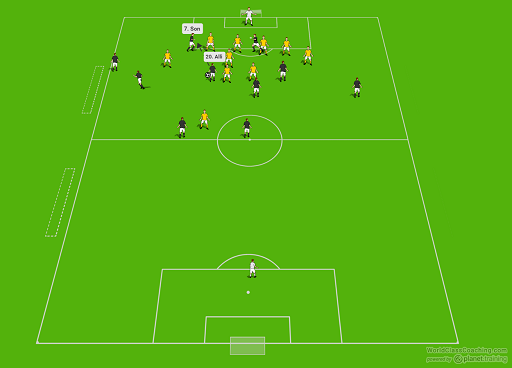
Son stands level on the outside of the opponents right back, Alli passes to his far foot and Son breaks into the penalty box. Son, like in the previous penalty he created, cuts back and the defender fouls him.
Tottenham’s rotation of positions and collective attacking is very difficult for the opponents to read.
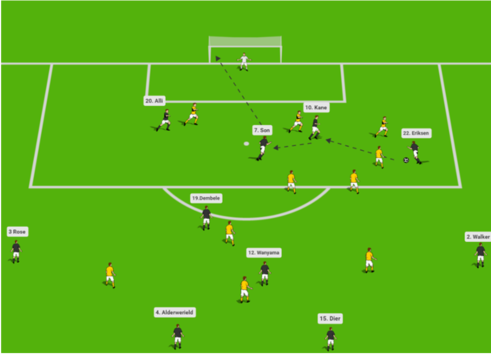
Kane is used to screen and suck in the central defender, Son times a run from the right hand side to support the drop pass then finishes.
CHAPTER 3 - BALL POSSESSION TO BALL POSSESSION OPPOSITION
This is an impressive area of Tottenham’s game, the intensity and energy put into winning the ball back instantly is very impressive. Rarely do Tottenham get caught out and they do leave themselves open when attacking at times.
The individual defending qualities of Wanyama, Vertonghen, Alderweireld and Dier allow Tottenham to play man for man at the back. When the ball breaks, Wanyama attempts to slow the counter down while the defenders track runners. The work rate of the more technical players is also very impressive with all players retreating quickly behind the ball with just Kane left forwards.
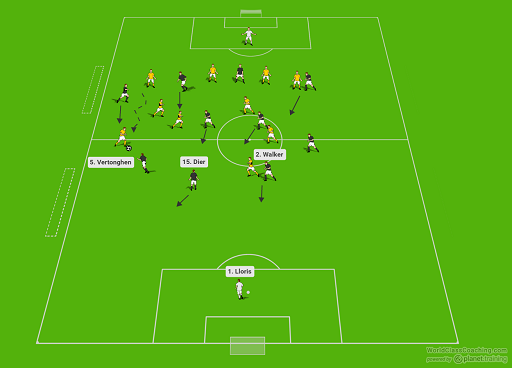
The image above shows a quick break from the opponents, Vertonghen objective is to delay. Vertonghen forces the opponent into the wide area and and jockeys. This delay gives the hard working Tottenham team to time to retreat and the counter is restricted to a normal build up.
Tottenham attack with high numbers often leaving two defenders back, with a screener in front when using a 4-2-3-1. When the opponents have been forced back Tottenham keep their lines tight so they can pounce on any losses of possession.
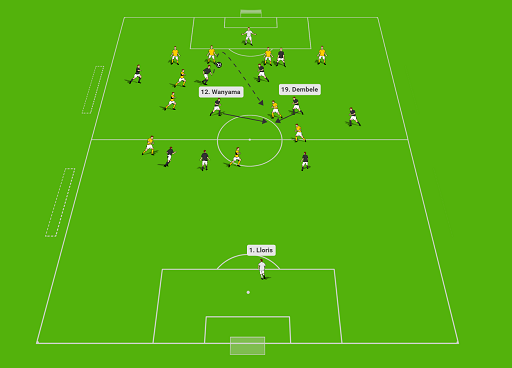
A pass is intercepted by the opponent and cleared in the air, although the opponents midfielder stills needs to bring down the ball, Dembele and Wanyama are quick to ambush the midfielder. A foul is given but the moment of a possible counter against disappears. The qualities of the two central midfielders in this moment allow Tottenham to take risk in attack.
When Tottenham play with a 4-2-3-1 Dembele and Wanyama sit together and screen. This allows both fullbacks to attack and open the field while the Creative players play more centrally.
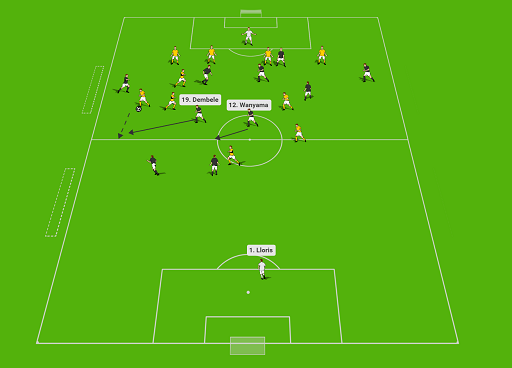
With less numbers in the last line to defend, Dembele and Wanyama need to be in position to delay the counter attack. The image above shows Dembele moving over to slow down the counter attack while the rest of the team retreat.
Tottenham at times attack quickly with just the 3 forwards making runs, although they’re outnumbered their pro-active movement can still create goal scoring opportunities.
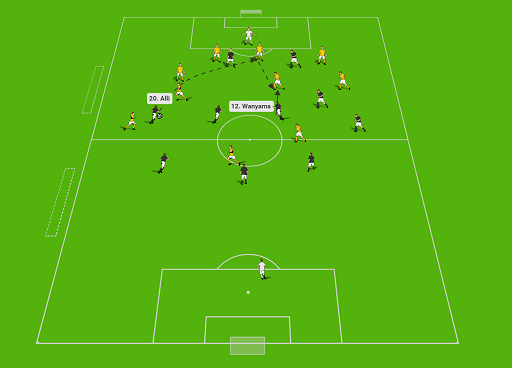
If the ball is lost, the midfield unit of Rose, Walker and Wanyama and Dembele quickly react to win the ball in the middle third. The image shows Wanyama winning the ball and breaking forwards.
Defending the long ball counter is an area Tottenham are very strong at. The first defender challenges to disturb the first ball, in the EPL most strikers are strong, good at screening and winning long balls.
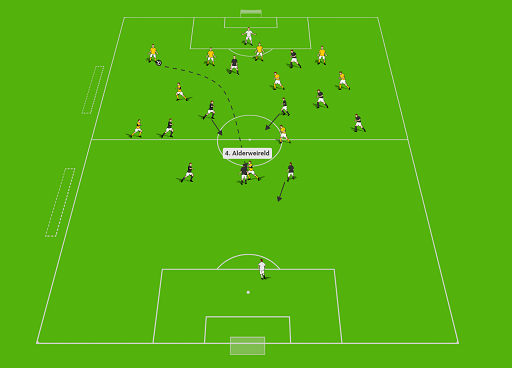
In this situation Tottenham always have a player covering the possible flick on. All Tottenham defenders are mobile and quick so an on running player can be delayed. The other area to cover is if the ball is dropped back to on running midfielders, again Tottenham have two midfielders who recognise the risk and are ready to disturb or intercept this pass.
When counter attacks develop and delaying is not possible defenders may have to commit to try and stop the danger. Tottenham central defenders and central midfielders have very good defensive skills and can read the dangers of these moments very well.
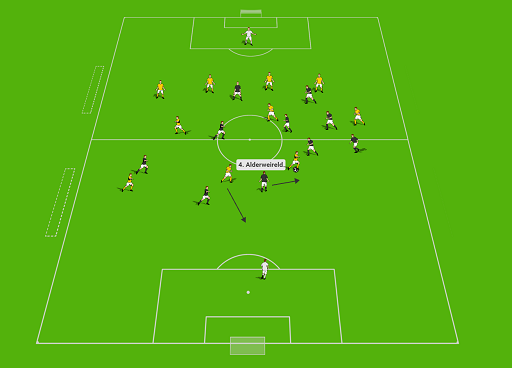
Alderweireld is in a situation that if the opponent breaks past him, a goal scoring opportunity may develop. The striker attempts to flick the ball past but Alderweireld blocks the ball and it is deflected out.
While the game is end to end key moments happen that a coach needs to work on. Firstly Tottenham have selected players that fit the profile of their many playing styles, the coach then enforces tactics and works on them in training.


